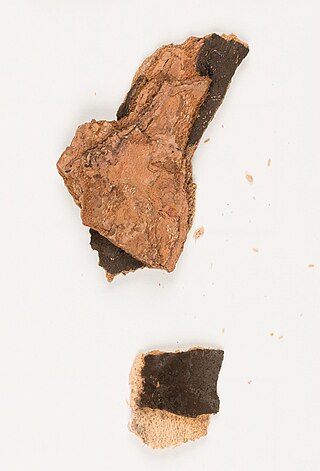
Withania somnifera, known commonly as ashwagandha or winter cherry, is an evergreen shrub in the Solanaceae or nightshade family that grows in India, the Middle East, and parts of Africa. Several other species in the genus Withania are morphologically similar.

Trichosanthes cucumerina is a tropical or subtropical vine. Its variety T. cucumerina var. anguina raised for its strikingly long fruit. In Asia, it is eaten immature as a vegetable much like the summer squash and in Africa, the reddish pulp of mature snake gourd is used as an economical substitute for tomato. Common names for the cultivated variety include snake gourd, serpent gourd, chichindapadwal and Snake Tomato.

Alternaria is a genus of Deuteromycetes fungi. All species are known as major plant pathogens. They are also common allergens in humans, growing indoors and causing hay fever or hypersensitivity reactions that sometimes lead to asthma. They are present in the human mycobiome and readily cause opportunistic infections in immunocompromised people such as AIDS patients.

Alternaria alternata is a fungus causing leaf spots, rots, and blights on many plant parts, and other diseases. It is an opportunistic pathogen on over 380 host species of plant.
Alternaria raphani is a fungal plant pathogen.
Alternaria dauci is a plant pathogen. The English name of the disease it incites is "carrot leaf blight".

Alternaria solani is a fungal pathogen that produces a disease in tomato and potato plants called early blight. The pathogen produces distinctive "bullseye" patterned leaf spots and can also cause stem lesions and fruit rot on tomato and tuber blight on potato. Despite the name "early," foliar symptoms usually occur on older leaves. If uncontrolled, early blight can cause significant yield reductions. Primary methods of controlling this disease include preventing long periods of wetness on leaf surfaces and applying fungicides. Early blight can also be caused by Alternaria tomatophila, which is more virulent on stems and leaves of tomato plants than Alternaria solani.

Alternariol is a toxic metabolite of Alternaria fungi. It is an important contaminant in cereals and fruits. Alternariol exhibits antifungal and phytotoxic activity. It is reported to inhibit cholinesterase enzymes. It is also a mycoestrogen.

Alternariosis is an infection by Alternaria, presenting cutaneously as focal, ulcerated papules and plaques. Treatment with itraconazole has been reported.
The citrus gummy bark viroid is a strain of Hop stunt viroid, and thus is a member of the genus Hostuviroid.

Wurfbainia villosa, also known by its basionym Amomum villosum, is a plant in the ginger family that is grown throughout Southeast Asia and in South China. Similar to cardamom, the plant is cultivated for its fruits, which dry into pods when mature and contain strongly aromatic seeds. W. villosa is an evergreen plant in the ginger family, grow in the shade of the tree, 1.5 to 3.0 m high, whose branches and leaves are similar to ginger's. W. villosa has a characteristic that flowers spread on the ground can bear fruit while flowers on the branches can not. Its flowers bloom in March and April and are the colour of white jade.
Phytophthora pseudosyringae is a semi-papillate homothallic soil-borne plant pathogen causing root and collar rot of broadleaf tree species in Europe. It is associated with necrotic fine roots and stem necroses of Fagus sylvatica and Alnus glutinosa, and isolates are moderately aggressive to fine roots of oaks and beech (Nothofagus), highly aggressive to holly leaves and apple fruits, and slightly pathogenic to alder bark. It belongs to the class of oomycetes and is often described as a ‘fungal-like’ organism since they form a heterotrophic mycelium as the ‘true fungi’, but in contrast, their cell wall lacks chitin and is composed only of cellulose and glucans.
Grapevine virus B is plant virus species in the genus Vitivirus. It is associated with rugose wood symptoms in grapevine.

Cryptostroma corticale is a species of fungus that causes sooty bark disease of maples, particularly sycamore. The spores grow profusely under the bark of affected trees or stacked logs. The fungus causes disease and death in trees, and the spores are allergenic and cause a debilitating pneumonitis in humans.

Orientus ishidae, common name Japanese leafhopper or Mosaic leafhopper, is a species of leafhoppers belonging to the family Cicadellidae and subfamily Deltocephalinae.
Alternaria tenuissima is a saprophytic fungus and opportunistic plant pathogen. It is cosmopolitan in distribution, and can colonize a wide range of plant hosts. Colonies of A. tenuissima produce chains on agar growth media. The fungus often forms concentric ring patterns on infected plant leaves. This species produces the allergen Alt a 1, one of the most important outdoor seasonal fungal allergens associated with allergy and asthma provocation. In rare circumstances, this species is also known to infect immunosuppressed humans and animals.
Phytophthora hydropathica is an oomycete plant pathogen that is found in aquatic environments such as irrigation and river water. The pathogen was previously classified as P. drechsleri Dre II before being categorized as its own distinct species. P. hydropathica has been primarily found in association with ornamental plant nurseries. The pathogen has been isolated throughout the Southern United States, as well as internationally in Mexico, Italy, and Spain.
Blumeriella kerriae is a species of fungus in the family Drepanopezizaceae.

Tomato brown rugose fruit virus (ToBRFV) is a plant virus in the genus Tobamovirus that was first described in 2015. It has spread rapidly since it was first noted in Jordan and Israel. The main hosts are tomato and peppers. The virus causes symptoms including mosaic and distortion of leaves and brown, wrinkly spots (rugose) on fruits. Outbreaks can be severe and leave fruit unmarketable.
Basidiophora is a genus of oomycetes belonging to the family Peronosporaceae. It is a water mold that causes downy mildew disease on plants such as the New England aster.










